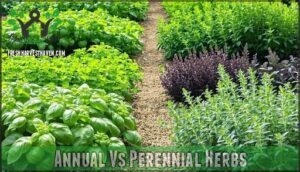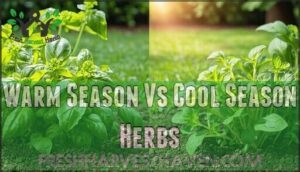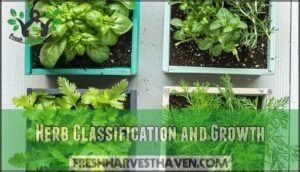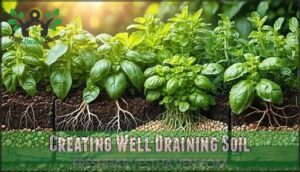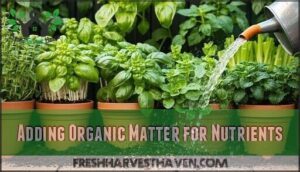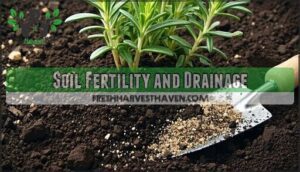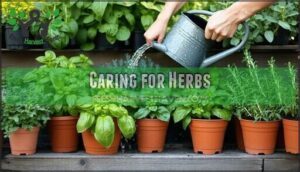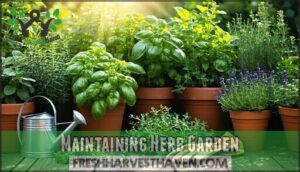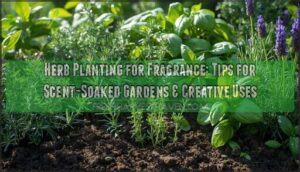This site is supported by our readers. We may earn a commission, at no cost to you, if you purchase through links.
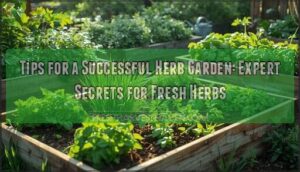 Success with your herb garden starts with smart planning and consistent care.
Success with your herb garden starts with smart planning and consistent care.
Choose a sunny location with well-draining soil, grouping herbs by their water needs—Mediterranean herbs like rosemary prefer drier conditions while basil craves moisture.
Start with easy-to-grow varieties like parsley, chives, and oregano.
Water at soil level to prevent fungal issues, and pinch flowers to keep leaves tender. Don’t overwater; most herbs thrive with slight neglect.
These tips for a successful herb garden will transform your cooking, but there’s more to maximizing flavor and extending your harvest season.
Table Of Contents
- Key Takeaways
- Planning Herb Garden
- Selecting Herb Types
- Preparing Herb Soil
- Caring for Herbs
- Maintaining Herb Garden
- Frequently Asked Questions (FAQs)
- What is the most successful way to grow herbs?
- What are the best tips for growing herbs?
- What is the best layout for an herb garden?
- How to grow a successful herb garden?
- What month should you start an herb garden?
- What is the best advice for growing herbs?
- What herbs should not be planted together?
- Do herbs grow better in pots or ground?
- How do I prevent pests in my herb garden?
- What herbs can survive colder climates?
- Conclusion
Key Takeaways
- Choose the right location and soil – You’ll need at least six hours of direct sunlight daily and well-draining soil that prevents waterlogged roots, which kill more herbs than drought ever will.
- Group herbs by water needs – Don’t mix drought-tolerant Mediterranean herbs like rosemary with moisture-loving varieties like basil, as this creates watering conflicts and stressed plants.
- Start with easy varieties and harvest regularly – Begin with forgiving herbs like parsley, chives, and oregano, then pinch stems frequently to encourage bushy growth and prevent early flowering.
- Avoid overwatering and overfertilizing – Most herbs thrive with slight neglect and develop stronger flavors in moderately fertile soil, so water only when the top inch feels dry and feed sparingly.
Planning Herb Garden
A successful herb garden starts with smart planning that considers your space, sunlight, and daily cooking habits.
You’ll save time and boost your harvest by grouping plants with similar water needs and choosing the right containers or garden spots before you plant a single seed.
Choosing Right Location
When choosing your herb garden’s location, think sunlight exposure first—you’ll need at least six hours of direct sunlight daily for thriving herbs.
Position your herb garden near your kitchen for easy accessibility planning during meal prep.
Scout your yard’s microclimate considerations, looking for spots with natural wind protection.
Most importantly, make certain proper drainage solutions since waterlogged herb garden soil kills more herbs than drought ever will.
Consider incorporating raised garden beds for improved drainage and accessibility.
Selecting Containers or Raised Beds
After securing your sunny location, your herbs need proper housing. Raised beds excel at soil drainage, while herb garden containers offer flexibility to relocate plants as seasons change.
Size Considerations matter substantially—shallow containers stunt root development. Most herbs need at least 6 inches of bed depth, though deep-rooted varieties like parsley require 12 inches for maximum growth.
Give your herbs breathing room—cramped containers create weak roots and disappointing harvests.
Container Materials directly impact plant health:
- Cedar planters resist rot while providing natural insulation
- Steel raised beds offer durability and modern aesthetic choices
- Terra cotta containers promote excellent drainage solutions
- Food-grade materials guarantee safe herb consumption
Choose untreated, breathable materials that complement your garden’s style while prioritizing drainage solutions over appearance alone. Many gardeners find success using specialized garden containers for their herbs.
Grouping Herbs by Water Needs
With proper containers in place, you’ll need to match watering frequency with each herb’s natural preferences. Drought-tolerant herbs like rosemary and thyme despise soggy conditions, while cilantro and parsley crave consistent soil moisture.
Smart companion planting eliminates watering conflicts and simplifies maintenance routines.
- Group Mediterranean herbs (oregano, sage, lavender) together for minimal watering
- Cluster moisture-loving herbs (mint, chives, basil) in separate sections
- Check soil moisture by inserting your finger two inches deep before watering herbs
- Position containers based on natural drainage patterns in your space
- Adjust humidity levels around grouped plants using mulch or gravel
This strategic approach prevents both drought stress and root rot while streamlining your herb garden watering tips routine.
Selecting Herb Types
Choosing the right herbs sets the foundation for your garden’s success, so you’ll want to understand the key differences between plant types before making your selections.
Annual herbs like basil and cilantro complete their life cycle in one season, while perennials such as thyme and oregano return year after year, making them excellent long-term investments for your garden, as they are key differences.
Annual Vs Perennial Herbs
Nobody wants to replant their entire herb garden every spring, which makes understanding lifespan comparison essential for smart garden design.
Annuals like basil and cilantro offer intense flavor profiles but require yearly replanting, while perennials such as rosemary and thyme return season after season.
This cost analysis favors perennials long-term, though propagation methods vary by type.
When growing herbs, mixing both categories creates continuous harvests and diverse flavors throughout your herb gardening journey.
Warm Season Vs Cool Season Herbs
Understanding seasonal planting makes the difference between thriving herb gardens and disappointing harvests.
You’ll want to match your herb varieties to their preferred temperature ranges for ideal growth habits and flavor profiles.
- Warm season herbs like basil and oregano need temperatures above 70°F and will die when frost hits
- Cool season herbs such as cilantro and parsley prefer 60-70°F and bolt quickly in summer heat
- Climate impact determines when you plant each variety for maximum culinary uses
- Herb gardening success depends on respecting these temperature preferences
- Growth habits vary dramatically between seasons, affecting your harvest timing
Plan your herb garden around these natural rhythms for continuous fresh herbs year-round.
Herb Classification and Growth
Plant families hold the key to your herb garden’s success.
Most culinary herbs belong to specific families with shared growing needs.
| Family | Examples | Growing Conditions |
|---|---|---|
| Lamiaceae (Mint) | Basil, Rosemary, Thyme | Dry, sunny, well-drained |
| Apiaceae (Carrot) | Cilantro, Dill, Parsley | Cool, moist, partial shade |
| Asteraceae (Daisy) | Chamomile, Calendula | Full sun, moderate water |
| Amaryllidaceae | Chives, Garlic chives | Sun to part shade, moderate water |
Herb life cycles determine your garden’s longevity.
Annual herbs complete their growth in one season, requiring yearly replanting.
Perennial herbs return each year, expanding in size and offering better value.
Understanding these growth requirements and environmental factors helps you choose appropriate propagation methods for different herb varieties.
For ideal growth, consider container size requirements to accommodate each herb’s mature dimensions, ensuring optimal growth and healthy plants with the right container size and environmental conditions.
Preparing Herb Soil
Creating healthy soil is your foundation for thriving herbs, and you’ll need well-draining conditions that prevent waterlogged roots from rotting.
You can achieve this by mixing equal parts topsoil, compost, and coarse sand, then adding organic matter like worm castings to boost nutrients without overwhelming your plants, which helps in creating a balanced environment with well-draining conditions.
Creating Well Draining Soil
Building your herb garden soil requires getting the drainage solutions right from day one.
Create welldraining soil by mixing equal parts topsoil, compost, and coarse sand—this prevents waterlogged roots that kill herbs faster than frost.
Sandy soil needs extra compost for nutrients, while clay soil benefits from additional sand amendments.
Container choices and raised beds both need proper drainage holes.
Consider effective drainage products for ideal soil health.
Think of soil amendments as insurance for your herb garden soil—they’re the difference between thriving plants and expensive compost.
Adding Organic Matter for Nutrients
The secret to herb garden soil success lies in enriching it with organic matter.
Mix compost and worm castings directly into your soil preparation—these organic amendments transform ordinary dirt into a thriving ecosystem.
Compost benefits include improved soil structure and enhanced nutrient cycling, while worm castings act like slow-release organic fertilizers.
This combination boosts soil fertility naturally, creating the perfect foundation for flavorful herbs that’ll make your neighbors jealous.
Soil Fertility and Drainage
Once you’ve added organic matter, resist the urge to overfertilize. Herbs actually develop stronger flavors in moderately fertile soil—they’re like athletes who perform better when they train hard.
Focus on drainage solutions instead. Mix topsoil with sandy soil in a 2:1 ratio for ideal herb drainage.
For clay amendment, add perlite or gravel to prevent waterlogged roots. Check soil pH between 6.0-7.5 for best compost benefits.
Remember: quickdraining soil keeps Mediterranean herbs happy and prevents root rot.
Caring for Herbs
Once you’ve established your herb garden, proper care determines whether your plants thrive or merely survive.
The right watering schedule, pruning techniques, and harvesting methods will keep your herbs producing flavorful leaves throughout the growing season, utilizing the correct techniques.
Watering Techniques for Healthy Herbs
Now that you’ve crafted the perfect growing medium, watering techniques become your herbs’ lifeline. Most herbs thrive with consistent moisture—not soggy soil that drowns roots.
Check the top inch of soil; when it’s dry, it’s time to water. Water frequency depends on your setup: potted herbs need daily attention in summer heat, while ground plants handle seasonal adjustments better.
Drainage solutions matter more than you think—soggy roots spell disaster. Use watering methods like soaker hoses or drip irrigation to keep leaves dry and prevent disease.
Many gardeners find that growing common herbs such as basil and rosemary is quite rewarding. Humidity control helps indoor herbs flourish year-round.
Fertilizing and Pruning Herbs
Smart fertilizing and pruning techniques can transform your herb garden into a productive powerhouse. Most herbs prefer light feeding—heavy fertilizer types actually reduce flavor enhancement and compromise their natural pest resistance.
Less fertilizer means more flavor—your herbs perform best when they work a little harder for their nutrients.
Follow these essential herb garden care practices:
- Feed sparingly: Apply diluted fertilizer only when leaves appear pale, as over-fertilizing reduces essential oils
- Prune strategically: Cut stems above leaf nodes to encourage bushy growth habits and maximize yields
- Time it right: Stop pruning perennials 8 weeks before frost to allow proper winter hardening
Regular pruning herbs promotes continuous growth while maintaining ideal plant nutrition balance for superior flavor. To keep your herbs healthy, remember to check soil moisture regularly.
Harvesting and Storing Herbs
Once your herbs are properly fed and pruned, harvest timing becomes your next priority.
Cut herbs in early morning after dew dries but before heat intensifies – this captures peak essential oil content. Regular harvesting herbs promotes bushier growth, so snip frequently!
For specialized tools, consider options for successful herb gathering.
Herb storage options include freezing herbs (blanched or raw), herb drying in well-ventilated areas, or creating herb infused-oils and pestos.
These storing techniques and drying methods preserve flavors for months. Herb preservation maintains that garden-fresh taste year-round in your kitchen.
Maintaining Herb Garden
Your herb garden’s success depends on avoiding common pitfalls and adapting your care routine throughout the year.
Once you’ve mastered the basics of planting and initial care, maintaining a thriving herb garden becomes a matter of staying vigilant and adjusting your approach as seasons change.
Common Mistakes to Avoid
Overwatering herbs kills more gardens than drought ever will. Most herbs prefer slightly dry conditions, so water only when soil feels dry one inch down.
Overcrowding plants restricts airflow and invites disease—give each herb proper spacing.
Insufficient sunlight weakens growth and dilutes flavors; most herbs need six hours daily.
Neglecting pruning leads to woody, bitter leaves and early flowering.
Ignoring climate requirements means choosing incompatible varieties for your zone, setting yourself up for failure from day one.
Remember that herbs also need monthly fertilization for ideal growth.
Seasonal Care and Maintenance
Beyond avoiding common pitfalls, your herb garden thrives when you match care to seasonal rhythms.
Each season brings unique opportunities for herb maintenance and growth optimization.
- Spring Refresh: Pinch young shoots early to encourage bushier growth, divide overcrowded perennials like chives, and amend soil with fresh compost for nutrient cycling.
- Summer Heat: Water deeply in mornings to prevent afternoon wilting, provide shade cloth for delicate herbs during extreme temperatures, and maintain consistent soil moisture.
- Fall Cleanup: Harvest abundantly before first frost, prune back hardy perennials, and apply protective mulch around root zones for effective overwintering herbs and winter protection.
Tips for Indoor Herb Gardening
Your indoor herb garden thrives with proper Indoor Lighting—position containers near south-facing windows and rotate weekly for even growth.
Choose pots with drainage holes and appropriate Container Size (6+ inches deep).
Maintain Humidity Control through daily misting, especially during winter months. Water only when soil feels dry one inch down to prevent root rot.
To maximize growth in shaded areas, remember to enrich the soil.
Select suitable Herb Varieties and implement Pest Prevention through regular inspection for ideal results.
Frequently Asked Questions (FAQs)
What is the most successful way to grow herbs?
You don’t need expensive equipment or perfect conditions to succeed.
Choose a sunny spot with well-draining soil, start with easy herbs like basil and mint, and harvest regularly to encourage growth.
What are the best tips for growing herbs?
Choose sunny locations with well-draining soil, harvest regularly to encourage growth, and don’t overwater—most herbs prefer slightly dry conditions over soggy roots for ideal flavor development.
What is the best layout for an herb garden?
Group herbs by water needs and mature size.
Place tall perennials like rosemary in back, medium herbs like basil in middle, and low-growing thyme in front.
Keep aggressive spreaders like mint contained in separate pots or barriers.
How to grow a successful herb garden?
Place your garden in full sun with well-draining soil near your kitchen.
Start with easy herbs like basil and mint, harvest regularly, and don’t overwater—stressed herbs actually develop better flavor.
What month should you start an herb garden?
As spring awakens the earth from winter’s slumber, April through May offers the perfect window for starting your herb garden.
You’ll want to wait until after the last frost date in your area to avoid cold damage to tender seedlings.
What is the best advice for growing herbs?
You’ll thrive by providing full sun, well-draining soil, and avoiding overwatering. Regular pruning encourages bushy growth, while harvesting frequently maintains plant vigor and prevents early flowering.
What herbs should not be planted together?
Don’t plant mint with other herbs—it’ll take over your garden like an aggressive houseguest. Separate water-loving herbs from drought-tolerant Mediterranean varieties since they’ve conflicting needs.
Do herbs grow better in pots or ground?
It’s not rocket science – both work well! Ground herbs get more root space and natural rainfall, while pots offer better drainage control and mobility for ideal growing conditions.
How do I prevent pests in my herb garden?
Companion plant marigolds and garlic around your herbs to naturally deter pests. Regularly inspect leaves for early detection, then treat infestations with neem oil spray for effective, organic control.
What herbs can survive colder climates?
Hardy perennial herbs like chives, oregano, thyme, and sage can weather cold snaps with proper mulch protection. Most perennial and biennial varieties overwinter successfully when you’ve prepared them right.
Conclusion
Successfully growing herbs isn’t just wishful thinking—it’s proven science that transforms any gardener into a culinary wizard.
These tips for a successful herb garden work because they align with each plant’s natural requirements.
You’ll discover that proper drainage prevents root rot while strategic grouping maximizes water efficiency.
Regular harvesting actually encourages growth, creating an endless cycle of fresh flavors.
With consistent application of these methods, you’re guaranteed aromatic herbs that’ll elevate every meal.

